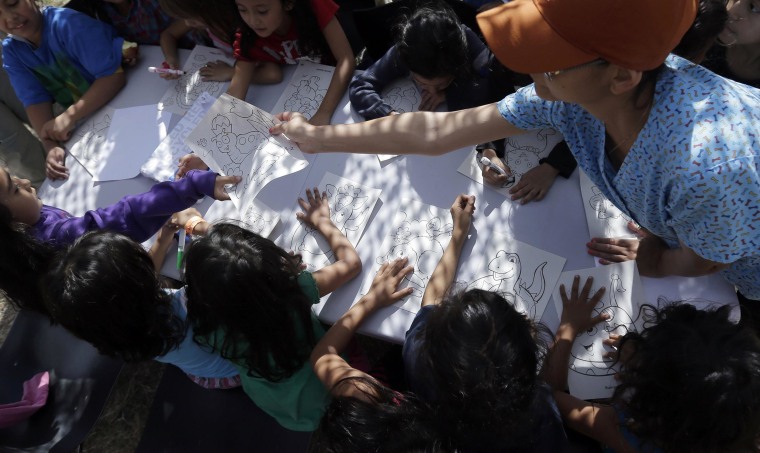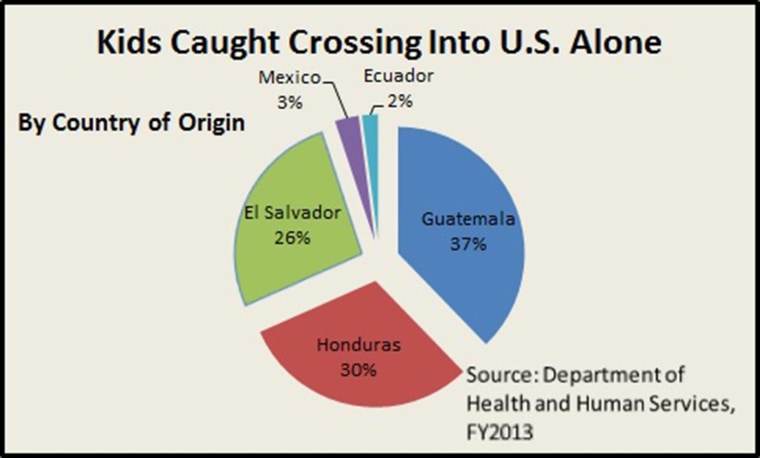They are known as UAC -– an acronym for unaccompanied alien children -- in the bureaucratic parlance of the federal government.
To some critics of laws that provide them with shelter while their cases are decided, they have no business in the U.S. and are a drain on law-abiding taxpayers.
Others, including advocates, volunteer foster families and even the United Nations, say they are like any other refugee fleeing crime and violence in their homelands, but even more vulnerable.
No matter what they are called, the unaccompanied children and teens that have descended on the Southwestern U.S. border in unprecedented numbers have triggered a political and humanitarian crisis -– and a costly one at that.
Here are some figures and facts about the unfolding story:
The numbers and the system
The U.S. Customs and Border Protection agency says that apprehensions of undocumented immigrants along the Southwestern U.S. border remain near historic lows, but agents have seen a sharp increase in the number of unaccompanied minors trying to enter the country illegally over the past five years. Over the first 8 1/2 months of fiscal year 2014, 52,193 unaccompanied minors have been taken into custody -- a 99 percent increase over 2013.
In Texas’ Rio Grande Valley alone, where most border crossings now occur, apprehensions have increased 178 percent over last year, with 37,621 unaccompanied minors apprehended so far this year.
Minors from Mexico or Canada who are apprehended at the border can be quickly returned to their home countries in expedited removal proceedings. But those from other countries – mostly teens but sometimes as young as toddlers – are transferred to the custody of the Office of Refugee Resettlement (ORR), part of the Department of Health and Human Services.

The ORR maintains custody of the minors only until they can be placed with family members in the U.S. or in foster care to await a decision on whether they can remain in the country. That occurs through a formal deportation proceeding, which can take months or years, during which they can petition an immigration judge to remain in the country.
The soaring number of migrant children has strained the system, forcing the federal government to scramble to open additional emergency facilities across the country and prompting President Barack Obama to request Tuesday for an emergency appropriation of $3.7 billion to fund the operation.
ORR also has seen its caseload jump sharply in recent years, rising from an average ofbetween 7,000 and 8,000 unaccompanied children from FY 2005 through 2011 to 24,668 last year, according to figures provided by HHS. This year, officials estimate, the office will receive at least 60,000 referrals.
The children
Where do they come from?: Four countries – El Salvador, Guatemala, Honduras and Mexico -- account for almost all of the unaccompanied minor cases, according to a 2014 report by the Congressional Research Service. As recently as 2009, Mexico accounted for 82 percent of the apprehended children, but the three Central American countries have propelled the recent influx, comprising 73 percent of those apprehended last year, it said.

Gender: About three-quarters of minors served by ORR are boys.
Average length of time in U.S. custody: About 35 days, according to the ORR.
Reunions: About 85 percent are reunified with their immediate or extended families while they go through immigration proceedings.
Deportations: The number of immigrants under 18 deported or turned away from the U.S. border has declined under the Obama administration, the Los Angeles Times reported on Sunday, citing data from Immigration and Customs Enforcement (ICE) received through a Freedom of Information Act request. The newspaper said the number of immigrants under 18 who were deported or turned away at ports of entry fell from 8,143 in 2008 -- the last year of the George W. Bush administration -- to 1,669 last year. The data did not differentiate between children that arrived in the U.S. unaccompanied or arrived with a parent or parents.
The law
Under the Homeland Security Act of 2002, Congress transferred the care and custody of unaccompanied minor immigrants from the former Immigration and Naturalization Service (INS) to HHS.
In 2008, the William Wilberforce Trafficking Victims Protection Reauthorization Act expanded the responsibilities of HHS, and required that the children must be placed "promptly" into the "least restrictive setting," that is in the best interest of the child. The act, a bipartisan effort that expanded on earlier efforts to protect unaccompanied children, was signed by George W. Bush shortly before he left office.
The law mandates that children be allowed to retain legal counsel and petition for the right to stay in the U.S. at an immigration hearing. Due to an overwhelming backlog in immigration cases -- there are currently over 360,000 pending cases pending, according to data gathered by the Transactional Records Access Clearinghouse at Syracuse University – the children often wait months, or years, for a judge to hear their case.
Follow NBC News Investigations on Twitter and Facebook.
The Vera Institute, a nonprofit think tank focused on criminal justice issues, estimates that about 40 percent of unaccompanied minors initially admitted into ORR custody are eligible for some kind of relief, including asylum or "special immigrant juvenile status," which allows children to later apply for legal residency.
Cost
It’s difficult to calculate the cost of apprehending, housing and adjudicating the cases of undocumented minor immigrants over time because a number of different agencies may deal with them, including Customs and Border Protection, ICE, and HHS/ORR and the Department of Justice, as well as local agencies or courts, such as family courts.
But it’s clear that it is increasing.
A budget brief for HHS's FY 2015 budget request, estimated that the agency would need $868 million to care for unaccompanied immigrant children, the same amount appropriated in FY2014 but up from $376 million in FY2013. But on May 30, the Congressional Research Service reported, the Office of Management and Budget requested more than twice that amount -- $2.28 billion – to operate the program.
In seeking a $3.7 billion emergency appropriation on Tuesday to address the crisis, the White House requested $1.8 billion for the HHS/ORR program alone for the remainder of the fiscal year.
It said the remaining funds would be used for the following:
- $1.1 billion for ICE, to pay for increased transportation and detention costs, stepped up enforcement and additional prosecution capacity for adults with children who cross the border unlawfully.
- $433 million for Customs and Border Protection for increased operational costs, improved information-sharing and collaboration with other law enforcement agencies increased border surveillance.
- $64 million for the Department of Justice to hire additional immigration judges and litigation attorneys , expand courtroom capacity, increase legal assistance to adults and custodians of the children and provide direct legal representation services to children in immigration proceedings.
- $300 million for the Department of State to support efforts to repatriate and reintegrate migrants to Central America, help governments in the region better control their borders and address the underlying root causes driving migration and mount media campaigns warning potential migrants and their families of the dangers of the journey and delivering the message that unaccompanied children are not given a permit to stay in the U.S.
Trends in illegal immigration
According to the Pew Research Center, the number of undocumented immigrants in the United States may have risen slightly after bottoming out during the recession. The center said that the number of undocumented immigrants in the U.S. dipped from 12.2 million in 2007 to 11.3 million in 2009 before rebounding to 11.7 million, as of March 2012.
A 2011 report by the Department of Homeland Security cited the high U.S. unemployment rate and increased border enforcement as the main reasons that illegal immigration slowed.
Related
Advocates Slam Administration on Border Kids
McCain Assails Obama's 'Selective Morality' on Border Kids
While the number of undocumented immigrants in the country appears to be down, the number of deportations under the Obama administration has remained at historically high levels.
In 2013, Immigration and Customs Enforcement reported 368,644 deportations, down from 409,849 the year before. The majority of those deported came from Mexico, Guatemala, Honduras and El Salvador.
According to the Department of Homeland Security, the top three municipalities sending children to the U.S. all are in Honduras, including the city of San Pedro Sula, which with 187 homicides per 100,000 people last year, is considered the world’s murder capital. Some 2,200 unaccompanied minors caught between January and May this year were from the city, which has accounted for 5 percent of all children apprehended since Oct. 1, DHS said.
